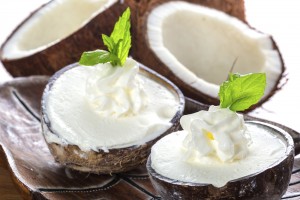Mintel reports on non-dairy ice cream
 Demand for non-dairy ice cream is booming in Germany, as dairy alternatives are no longer strictly marketed to consumers with special dietary requirements, but appeal to a wider health-conscious consumer base. Indeed, new Mintel research finds nearly two-thirds (63%) of German ice cream consumers are interested in non-dairy alternatives, such as almond or coconut based ice cream.
Demand for non-dairy ice cream is booming in Germany, as dairy alternatives are no longer strictly marketed to consumers with special dietary requirements, but appeal to a wider health-conscious consumer base. Indeed, new Mintel research finds nearly two-thirds (63%) of German ice cream consumers are interested in non-dairy alternatives, such as almond or coconut based ice cream.
Moreover, it seems German consumers are even willing to pay a premium price for these options, as one in five (20%) Germans say that they would be willing to pay more for non-dairy ice cream, rising to nearly one third (30%) among 16 to 24 year olds.
The high demand for non-dairy ice cream is also evident in other key European countries, with interest signaled by 78% of Polish, 69% of Italian, 68% of Spanish and 63% of French consumers. What’s more, the willingness to spend more on such alternatives seems to be pronounced across Europe, with 27% of consumer in Poland, 21% in Italy, 25% in Spain, and 18% in France agreeing they would pay a premium price for these options.
“While dairy alternatives were originally created for consumers with special dietary requirements, such as those who are lactose intolerant or suffering from allergies, today they represent more of a lifestyle choice, especially among younger generations,” said Julia Buech, Food and Drink Analyst at Mintel. “This is based on a strong combination of health and ethical reasons, as well as evolving taste preferences and the appeal of novel flavours.”
Responding to strong consumer demand, dairy-free ice cream is gaining ground in Germany, where the share of non-dairy launches reached a sizeable 8% of total ice cream introductions (excluding sorbets) compared to just 2% between 2013 and 2014, according to Mintel’s Global New Products Database (GNPD). In wider Europe, non-dairy ice cream is also expanding its niche, albeit at a more modest pace. According to Mintel, in 2015 the share of new dairy-free introductions reached 3% in Europe overall, up from 2% in 2014 and 1% in 2013.
Mintel research has also found that even though the UK has held the crown as the most innovative non-dairy ice cream market for years, it looks like German manufacturers have upped their game in 2015. Indeed, the UK was leading non-dairy ice cream innovation between 2013 and 2015 overall, accounting for 19% of total launches in Europe, followed by Germany (16%) and Italy (14%). However, looking at 2015 alone, Germany launched 26% of all new non-dairy ice creams, outpacing both the UK (17%) and Italy (12%).
Mintel research has also found that even though the UK has held the crown as the most innovative non-dairy ice cream market for years, it looks like German manufacturers have upped their game in 2015. Indeed, the UK was leading non-dairy ice cream innovation between 2013 and 2015 overall, accounting for 19% of total launches in Europe, followed by Germany (16%) and Italy (14%). However, looking at 2015 alone, Germany launched 26% of all new non-dairy ice creams, outpacing both the UK (17%) and Italy (12%).
Launch activity in Germany’s non-dairy ice cream sector is increasingly shifting from soy to other alternatives. The share of soy-based launches decreased from close to 100% in 2012 to 35% in 2015, in the favour of alternatives based on coconut, almond, rice, and, more recently, lupine. Non-soy alternatives thus accounted for 65% of overall non-dairy ice cream launches in 2015.
“While soy’s image has suffered from negative associations related to both health and the environment, new non-dairy ice cream alternatives have profited from a taste and texture standpoint,” said Buesch. “Moreover, they are being explicitly utilised to underline a premium, indulgent positioning. Super-premium has in fact become the playing field of the majority of new launches in Germany, with decadent flavours such as salted caramel, apple pie, or coconut-bourbon vanilla prevailing.”
What’s more, organic and ethical-production claims are also on the rise, accounting for an impressive 90% of all newly introduced non-dairy ice cream products in Germany in 2015. This comes as almost half (47%) of German consumers are interested in buying organic ice cream, with 28% willing to pay more for it – rising to two out of five (37%) 25-34 year olds. Meanwhile, three out of five (59%) Germans show an interest in ice cream that contains locally sourced ingredients such as milk from local farmers, and half (50%) of German consumers are keen on buying ice cream that is handmade.
“Having escaped the realm of substitutes primarily for people with dietary concerns, non-dairy ice cream launches capture the imagination of modern consumers who do not exclusively opt for dairy-free, yet welcome the new variety. Far removed from a specialist dietary positioning, the new wave of non-dairy products focus strongly on taste and indulgence, and are designed to compete with the best of what dairy-based ice cream has to offer, ” Buesch concludes.

































